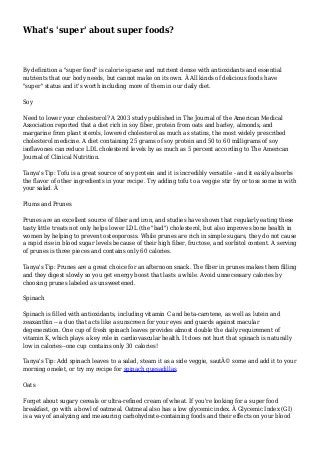
What's 'super' about super foods?
- 1. What's 'super' about super foods? By definition a "super food" is calorie sparse and nutrient dense with antioxidants and essential nutrients that our body needs, but cannot make on its own.  All kinds of delicious foods have "super" status and it's worth including more of them in our daily diet. Soy Need to lower your cholesterol? A 2003 study published in The Journal of the American Medical Association reported that a diet rich in soy fiber, protein from oats and barley, almonds, and margarine from plant sterols, lowered cholesterol as much as statins, the most widely prescribed cholesterol medicine. A diet containing 25 grams of soy protein and 50 to 60 milligrams of soy isoflavones can reduce LDL cholesterol levels by as much as 5 percent according to The American Journal of Clinical Nutrition. Tanya's Tip: Tofu is a great source of soy protein and it is incredibly versatile - and it easily absorbs the flavor of other ingredients in your recipe. Try adding tofu to a veggie stir fry or toss some in with your salad.  Plums and Prunes Prunes are an excellent source of fiber and iron, and studies have shown that regularly eating these tasty little treats not only helps lower LDL (the "bad") cholesterol, but also improves bone health in women by helping to prevent osteoporosis. While prunes are rich in simple sugars, they do not cause a rapid rise in blood sugar levels because of their high fiber, fructose, and sorbitol content. A serving of prunes is three pieces and contains only 60 calories. Tanya's Tip: Prunes are a great choice for an afternoon snack. The fiber in prunes makes them filling and they digest slowly so you get energy boost that lasts a while. Avoid unnecessary calories by choosing prunes labeled as unsweetened. Spinach Spinach is filled with antioxidants, including vitamin C and beta-carotene, as well as lutein and zeaxanthin -- a duo that acts like a sunscreen for your eyes and guards against macular degeneration. One cup of fresh spinach leaves provides almost double the daily requirement of vitamin K, which plays a key role in cardiovascular health. It does not hurt that spinach is naturally low in calories--one cup contains only 30 calories! Tanya's Tip: Add spinach leaves to a salad, steam it as a side veggie, sauté some and add it to your morning omelet, or try my recipe for spinach quesadillas. Oats Forget about sugary cereals or ultra-refined cream of wheat. If you're looking for a super food breakfast, go with a bowl of oatmeal. Oatmeal also has a low glycemic index.  Glycemic Index (GI) is a way of analyzing and measuring carbohydrate-containing foods and their effects on your blood
- 2. sugar.  Foods, such as oatmeal, that has a low GI have been linked to a decreased risk of cardiovascular disease, type 2 diabetes, various cancers such as breast, colon and prostate.  Oats also help to provide lasting energy and keep hunger at bay. It's also an excellent source of soluble fiber, which is known to help reduce cholesterol. A half cup of dried oats has about 150 calories, and packs 5 grams of protein plus 4 grams of dietary fiber. Tanya's Tip: Watch out for instant oatmeal, as these may have added sugars. Instead, prepare ½ cup of dried oats in about 1 cup of water and then add a handful of your favorite berries and a tablespoon of nuts (I recommend almonds) YUM! Dark Chocolate Yes, dark chocolate absolutely qualifies as a super food that's packed with antioxidants. Dark chocolate offers a number of health benefits such as controlling blood sugar, lowering the risk of stroke, reducing the risk of cardiovascular disease and lowering blood pressure. Go for dark chocolate that is at least 70 percent cacao for optimal antioxidant power and health benefits. Tanya's Tip: Portion alert! Although dark chocolate is a healthy treat, keep in mind that a proper serving is one ounce, which has about 150 calories. For more delicious high fiber meal plans, recipes and tips on healthy eating, drinking and losing weight, check out my new book The Miracle Carb Diet: Make Calories and Fat Disappear - with Fiber! Tanya Zuckerbrot MS, RD, is a registered dietitian in New York City and author of the Miracle Carb Diet: Make Calories and Fat Disappear - with fiber as well as the bestselling Follow Tanya on Facebook, Twitter and LinkedIn, and visit her website Ffactor.com. http://www.foxnews.com/health/2014/02/04/what-super-about-super-foods/